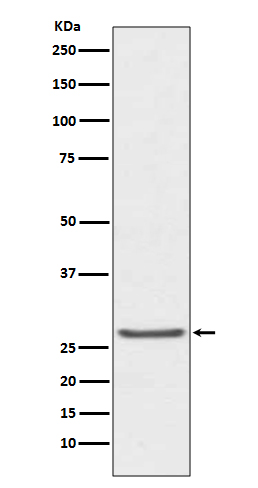
| WB | 咨询技术 | Human,Mouse,Rat |
| IF | 咨询技术 | Human,Mouse,Rat |
| IHC | IHC:1/100-1/200;IHF:1/50-1/200 | Human,Mouse,Rat |
| ICC | 1/50-1/200 | Human,Mouse,Rat |
| FCM | 咨询技术 | Human,Mouse,Rat |
| Elisa | 咨询技术 | Human,Mouse,Rat |
| Aliases | EPO; EPA; TIMP1; CLGI; ;TIMP1 |
| WB Predicted band size | Calculated MW: 23 kDa ; Observed MW: 26 kDa |
| Host/Isotype | Rabbit IgG |
| Antibody Type | Primary antibody |
| Storage | Store at 4°C short term. Aliquot and store at -20°C long term. Avoid freeze/thaw cycles. |
| Species Reactivity | Human |
| Immunogen | A synthesized peptide derived from human TIMP1 |
| Formulation | Purified antibody in PBS with 0.05% sodium azide,0.05% BSA and 50% glycerol. |
+ +
以下是3-4条关于TIMP1抗体的参考文献示例(内容基于公开文献概括,具体信息建议通过数据库核实):
---
1. **文献名称**: *"Tissue inhibitors of metalloproteinases: evolution, structure and function"*
**作者**: Brew K, Nagase H.
**摘要**: 该综述详细阐述了TIMP家族(包括TIMP1)的分子结构、功能及其在调控基质金属蛋白酶(MMPs)中的作用,并讨论了TIMP1抗体在疾病模型研究中的应用,如癌症和炎症性疾病中的表达检测。
---
2. **文献名称**: *"Anti-TIMP1 antibody as a novel diagnostic biomarker for colorectal cancer"*
**作者**: Jackson HW, et al.
**摘要**: 研究通过免疫组化和ELISA技术,验证了抗TIMP1抗体在结直肠癌患者血清和组织样本中的高特异性表达,提出TIMP1可作为潜在的肿瘤诊断标志物。
---
3. **文献名称**: *"Monoclonal antibody targeting TIMP1 reduces liver fibrosis in murine models"*
**作者**: Chen X, et al.
**摘要**: 该研究开发了一种靶向TIMP1的单克隆抗体,通过动物实验证明其能有效抑制肝星状细胞活化,减少胶原沉积,为抗纤维化治疗提供了新策略。
---
4. **文献名称**: *"Neutralizing TIMP1 antibody enhances chemotherapy efficacy in pancreatic cancer"*
**作者**: Schmidt A, et al.
**摘要**: 研究发现,使用抗TIMP1中和抗体可阻断TIMP1介导的肿瘤微环境重塑,增强吉西他滨等化疗药物在胰腺癌模型中的抗肿瘤效果,提示其联合治疗的潜力。
---
建议通过PubMed或Google Scholar输入关键词“TIMP1 antibody”或“anti-TIMP1”获取更多最新文献。如需具体文献全文链接或DOI号,可进一步说明。
TIMP1 (Tissue Inhibitor of Metalloproteinases 1) is a key regulator of extracellular matrix (ECM) homeostasis, primarily known for inhibiting matrix metalloproteinases (MMPs), particularly MMP-9. by binding to their catalytic domains. It plays dual roles in both suppressing ECM degradation and exerting MMP-independent functions, such as promoting cell survival, growth, and modulating immune responses. Dysregulation of TIMP1 is implicated in pathological processes, including cancer progression, fibrosis, and inflammatory diseases.
TIMP1 antibodies are essential tools for studying its expression, localization, and functional mechanisms. These antibodies (monoclonal or polyclonal) are widely used in techniques like Western blotting, immunohistochemistry, and ELISA to quantify TIMP1 levels in tissues or biological fluids. In research, they help elucidate TIMP1's paradoxical roles—for example, its tumor-suppressive MMP inhibition versus oncogenic signaling in certain cancers. Clinically, TIMP1 antibodies aid in biomarker studies, as elevated TIMP1 correlates with poor prognosis in cancers like colorectal or breast cancer and severity in liver fibrosis.
Antibodies targeting specific TIMP1 epitopes (e.g., N-terminal MMP-binding domain or C-terminal regions) enable functional studies, such as blocking TIMP1-MMP interactions or dissecting its signaling pathways. Recent therapeutic explorations also investigate TIMP1-neutralizing antibodies to counteract its pro-fibrotic or pro-tumorigenic effects.
×